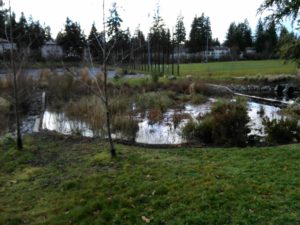Hybrid Wetpond/Wetland at Yauger Park LID Stormwater Facility
Case Study: Published | Updated: | | Olympia, Washington | 12816310300- Category
- category_listing(s)
- Building Type
- Infrastructure
- Innovation
- Bioretention Areas: WetlandsWetponds
- Jurisdiction
- Olympia, Washington
- Parcel
- 12816310300
- Officials
- Eric Christensen | City of Olympia Public Works
Marcus Goodman | City of Olympia
Todd Stamm | City of Olympia
Fran Eide | City of Olympia
Tom Hill | City of Olympia - Team
-
Fran Eide
|
approving-official
Tom Hill | approving-official
Andy Haub | Designer
Eric Christensen | approving-official
Marcus Goodman | approving-official
Erik Davido | Designer
Tanja Wilcox | subcontractor
Todd Stamm | approving-official

The Yauger Park Low Impact Development (LID) Project provides for enhanced water quality treatment, additional storage volume and an enhancement to the recreational facilities at the City of Olympia’s Yauger Park regional stormwater facility. This green infrastructure stormwater treatment project includes bioretention areas (Wetland and Wetponds) that harbor native flora and fauna to promote biofiltration. The bioretention areas of wetlands and wet ponds function as educational and recreational purposes for the community. It also functions to innovate Best Management Practices within each other for demonstration for private property owners and municipal jurisdictions.
The Yauger Park Low Impact Development (LID) is on property owned by the City of Olympia and for all intents and purposes it is considered to be private property and subject to the same regulatory standards as any other private development. A hybrid wet pond/wetland facility was installed to demonstrate how innovative methods can be employed by property owners and developers to help meet the City’s requirements for either or both type of facility, and comply with all applicable Stormwater Regulations, and Building Standards, and Engineering Standards. In the process, the facility helped the City meet performance standards for its own NPDES permit and evolving LID Best Management Practices (BMP’s). According to City staff no variances or deviations from the standards were sought or granted, although approval of the hybrid system was innovative. Site disturbing activities triggered the requirement for: grading and erosion controls permits and the requirements and guidelines held within Olympia’s adopted Stormwater Manual consistent with the Stormwater Manual for Western WA.
| Code Requirement | Compliance Path |
|---|---|
|
Drainage Design and Erosion Control Manual For Olympia: Chapter 9, Biofiltration Treatment Facilities and Chapter 10, Wetpool Facilities. |
Prescriptive path following a close outline of code, approved by City Stormwater Engineer using the code for bioswales; also for stormwater wetland construction following only Distribution of Water Depths BMP 10.30 for Stormwater Treatment Wetland. |
| WA State Department of Ecology, Stormwater Management Manual for Western Washington, Vol. 1-5, 2005 |
Prescriptive path with creation of a hybrid wetland. Combinations of BMP’s used to meet renovation requirements. |
| Limitations on seasonal grading in Percival Creek Basin per City of Olympia Stormwater Manual | Usage of Clear Creek Solutions Modeling formulas to determine seasonal grading limitations. Summary of results in David Consulting Group Report |
| Washington State Department of Ecology, Construction Stormwater General Permit | Prescriptive state regulations followed in creation of stormwater wetpond and dealing with stormwater during construction. |
| Code Requirement | Compliance Path |
|---|---|
|
Drainage Design and Erosion Control Manual For Olympia: Chapter 9, Biofiltration Treatment Facilities and Chapter 10, Wetpool Facilities. |
Prescriptive path following a close outline of code, approved by City Stormwater Engineer using the code for bioswales; also for stormwater wetland construction following only Distribution of Water Depths BMP 10.30 for Stormwater Treatment Wetland. |
| WA State Department of Ecology, Stormwater Management Manual for Western Washington, Vol. 1-5, 2005 |
Prescriptive path with creation of a hybrid wetland. Combinations of BMP’s used to meet renovation requirements. |
| Limitations on seasonal grading in Percival Creek Basin per City of Olympia Stormwater Manual | Usage of Clear Creek Solutions Modeling formulas to determine seasonal grading limitations. Summary of results in David Consulting Group Report |
| Washington State Department of Ecology, Construction Stormwater General Permit | Prescriptive state regulations followed in creation of stormwater wetpond and dealing with stormwater during construction. |